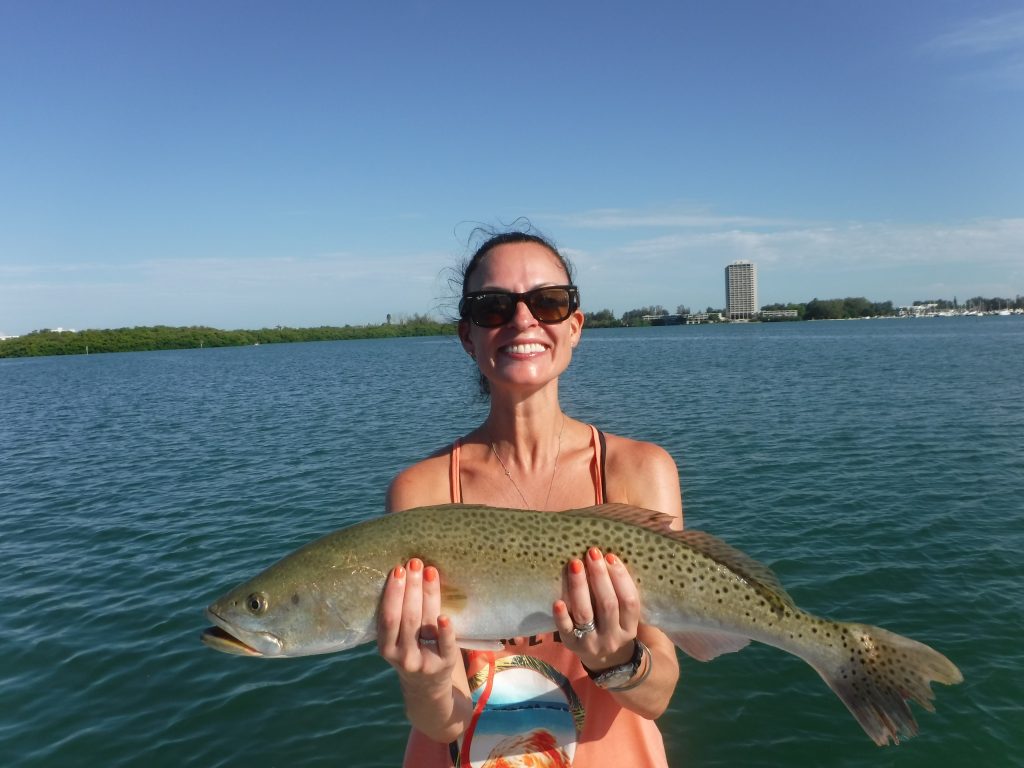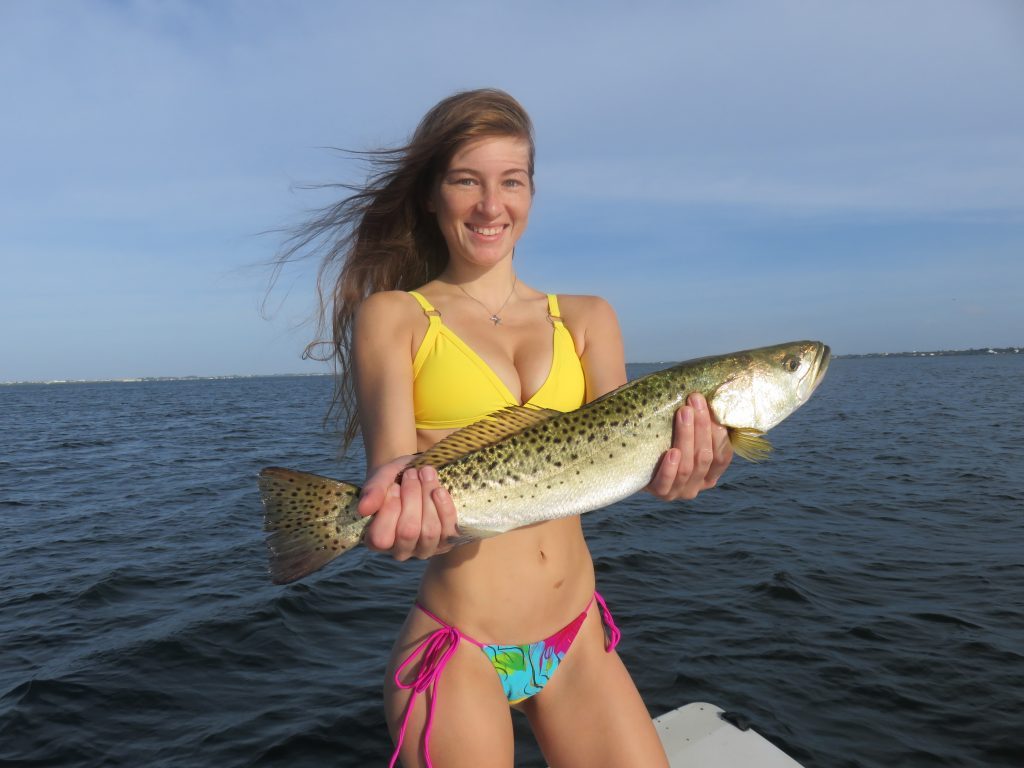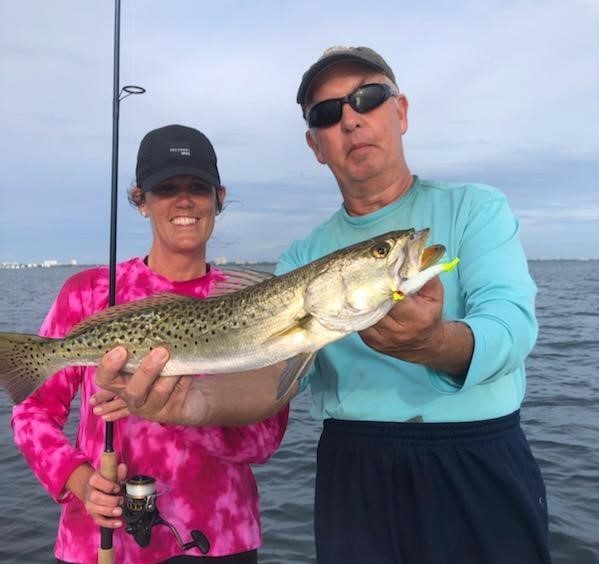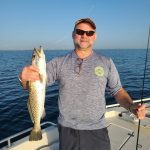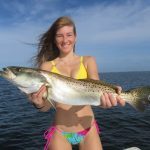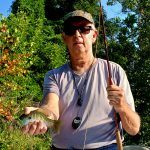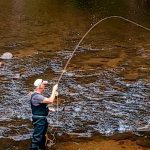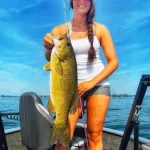Speckled Trout Fishing – 18 Pro Tips
This article will list 18 effective speckled trout fishing tips from Capt Jim. Many anglers from Texas to the Mid Atlantic enjoy fishing for speckled trout. Speckled trout are without a doubt one of the most popular inshore saltwater game fish. Anglers fishing for speckled trout mostly target them on the fertile, shallow flats. Trout species feed on a wide variety of bait fish and crustaceans. Many tactics and baits that produce other inshore saltwater species work well on speckled trout, too.
Speckled trout are a extremely popular inshore saltwater species. Properly known as spotted sea trout, or Cynoscion nebulosus, speckled trout are plentiful in the coastal inshore waters from Texas to Chesapeake Bay. Speckled trout prefer shallow grassy flats where they feed on bait fish as well as shrimp and other crustaceans.
Anglers fishing for speckled trout need to understand their habits in order to be successful. They are found on shallow flats, around structure, in passes and inlets, and in the surf. Speckled trout make both local and regional seasonal migrations. Changing tactics and locations throughout the year is the key to having success fishing for speckled trout.
Speckled trout fishing – 18 effective tips
Here is Capt Jim’s list of effective and productive speckled trout fishing tips. They are applicable to anglers chasing them throughout the country. Speckled trout behave quite similar no matter where they are found.
1) Best speckled trout fishing tackle
Tackle for speckled trout fishing is pretty straightforward. The same outfits that are used for most inshore fishing situations will do fine when pursuing trout. Capt Jim likes a 7 foot medium-light action rod with a 2500-3000 series reel spooled with 1o pound monofilament or 20 pound braided line works well. As in other forms of saltwater fishing, a 30 inch piece of 30 pounds fluorocarbon leader is used.
Anglers can certainly use baitcasting tackles as well. It is much more popular along the Gulf Coast from Louisiana to Texas. Anglers often cast heavier lures and rigs and baitcasting tackle works very well in this application. Also, there is always the chance to hook a bull redfish.
2) Best fishing spots for speckled trout
Spotted sea trout, also known as speckled trout, are fun to catch, beautiful, and terrific eating! They are most often found in schools or groups of fish. Therefore, once one is caught, anglers can expect to catch more. This is particularly true in cooler weather when trout bunch up tightly. Speckled trout relate heavily to grass. They will often be found over submerged vegetation, also known as “grass flats”. Grass holds the shrimp and bait fish that speckled trout feed on. They will also be caught around docks and bridges, around oyster bars, in passes and inlets, and out on the beaches.
Average sized speckled trout will be found in schools, usually in water between five and 20 feet deep, depending on the area. However, larger trout are often loners are are caught in very shallow water. These larger fish hunt alone and are found around oyster bars, in potholes, under docks, and in any prime ambush location. Occasionally, anglers will run across schools of larger fish.
3) Best speckled trout fishing techniques
Speckled trout are often targeted in slightly deeper water, particularly on the flats. By “deep” Capt Jim is referring to water between 6 feet and 10 feet deep. Therefore, tactics will change a bit. Drifting expansive flats while casting lures and live bait is a very productive technique. In deeper water, drifting and bouncing a jig or bait works well. Drifting allows anglers co cover a lot of water in search of fish.
One of the oldest and still most productive techniques for catching speckled trout on the flats is a popping cork rig. A popping cork is a float that makes a noisy popping sound when twitched sharply. A live bait or even and artificial lure is then fished 2 feet to 3 feet under the float. This noise simulates the sound that fish make when feeding on the surface. It excites speckled trout and other species, calling them to the bait.
The most commonly used bait under a popping cork is a live shrimp. It would be safe to say that more trout were landed using a live shrimp under a popping cork that all other angling methods combined. The reason is simple; it is deadly effective. The float calls the fish in to the bait and suspends the shrimp just above the grass. It also gives anglers a visual aid as the float disappears when a speckled trout takes the shrimp. Popping corks come in a wide variety of designs, colors, and shapes, but they all work the same.
4) Live bait is very effective for speckled trout
A # 1/0 live bait hook works well when fishing live shrimp for trout. If current or wind is present, a small split shot may be required a foot or so above the hook. Shrimp are hooked in the head just under the horn and in front of the brain. This keeps the shrimp alive and kicking, however, hopefully not for very long!
Live bait fish can be used under a popping cork as well. A 2 inch to 3 inch live grunt or live pin fish works very well and will often catch larger trout that shrimp will. The smaller 12 inch to 15 inch trout will not usually take these larger baits. They are also ignored by bait stealers such as pin fish, blowfish, and other undesirable species.
Lastly, artificial lures are used under these noisy floats as well. Artificial shrimp such as the Gulp Shrimp work well under a popping cork. Gulp Shrimp are heavily scented and fish almost the same as a live shrimp does. Capt Jim uses them on a 1/16 ounce jig head under a popping cork. Other manufacturers make very lifelike artificial shrimp. A soft plastic shad tail bait on a very light jig head can also be a productive combination.
5) Speckled trout fishing with lures
Speaking of the jig and grub combination, it is without a doubt the most popular artificial lure for anglers targeting speckled trout. Trout love the action of these lures! The lure is cast out and allowed to fall a few feet. It is and jerked up a foot or so and allowed to fall again. Trout and other game fish find this action deadly and in most instances will take the bait as it falls. Capt Jim prefers the Bass Assassin 4″ Sea Shad, but there are many fine baits on the market.
Soft plastic baits come in a myriad of sizes and colors. Don’t get overwhelmed, they are all basically the same and are all effective when fished correctly. Jigs come in weights. Most of the trout in Capt Jim’s area are caught between 5 and 8 feet deep. This makes a 1/4 ounce jig the best choice. In his opinion, jig head color matters very little. However, white, and chartreuse are the most popular colors. Unpainted jig heads work fine.
The other soft plastic bait that Capt Jim uses on his fishing charters is the 3″ Gulp! Shrimp. This lure really bridges an artificial lure with live bait. Speckled trout will find it easier and hang on a bit longer. The scent can really make a difference, particularly when the bite is tough.
6) Best speckled trout fishing lures
Three inch paddle tail or shad tail grubs are the most popular. Twister tail baits can be effective, however pin fish will oftentimes dip the tail off. This can be true of shad tail baits as well. Glow, chartreuse, white, pink, olive, root beer, and new penny are the most popular colors. The “clear water light color and darker lures and darker water” theory is a good approach. But, presentation and location are the overriding factors.
Plugs catch plenty of speckled trout as well. One downside to using plugs are the multiple trouble hooks. This can make releasing speckled trout a bit more complicated and may damage the fish. Since most of the speckled trout caught will be released this is a factor to consider. Treble hooks can be replaced with single hooks. Suspending plugs such as the MirrOlure MirroDine are the most productive plugs. Top water plugs early and late in the day fished over shallow bars will catch some trophy speckled trout.
Spoons are another productive artificial lure when fishing the grass flats for speckled trout. Anglers fishing the deeper flats normally opt for a half ounce gold or silver spoon with an open treble hooks. Those seeking larger trout in shallow water will do better with a half ounce gold weedless spoon.
7) Big speckled trout are often found in shallow water
As stated earlier, anglers seeking larger fish will do best fishing shallower water. This might sound contradictory, but larger fish are found in shallower water while the schools of smaller to average sized fish are found in the deeper water. The theory is that these larger fish are loners and do not need the protection of the school.
Oyster bars and shallow flats on the higher tide stages are prime areas to catch a larger speckled trout. Top water plugs early in the morning are productive and will produce some explosive strikes. Weedless spoons and light weedless soft plastic baits are also effective. Live bait is difficult to fish in this very shallow water, with the exception being casting live shrimp into open potholes.
8) Winter and night fishing for speckled trout
In the wintertime speckled trout may move off of the flats if the water temperature dips down into the low 50s. They will migrate to nearby channels and deeper canals where the water temperature is warmer near the bottom. Fish can be difficult to locate when this happens. However when a school is located the action will be fast and furious. A live shrimp or jig bounced on the bottom will produce.
Anglers to catch speckled trout at night as well. The proven technique is to fish lighted docks but especially area bridges. Most bridges have streetlights and the shadow line where the shadow hits the lighted water on the up current side is generally the most productive spot. Anglers can anchor in the spot and cast live shrimp or jigs out. This is a great way to beat the summer heat.
9) Fishing for speckled trout on the shallow flats.
Many anglers targeting speckled trout do so on the shallow grass flats, particularly those up in backwater areas. Tidal creeks are great spots as well. While the deeper grass flats attract schools of smaller speckled trout along with bluefish, Spanish mackerel and other species, larger trout often prefer the shallower water.
Fishing in water that shallow presents some challenges. Fish are quite spooky when there’s barely enough water to cover their backs! This means that anglers must be stealthy when approaching them. Many shallow draft skiffs are specially designed to be extra quiet on the flats. Wading is also a great way to sneak up on skittish trout.
10) Understand the effect of tides when fishing for speckled trout on the flats
Tides are critical when targeting speckled trout in shallow water. Most anglers prefer a low, incoming tide. Trout will also stage in what are called “potholes”. These are slight depressions in the shallow grass flats. The difference can be minimal, but enough to make a difference. A 3 foot depression on a flat that has 10 inches of water can hold an entire school of fish. This happens in winter when tides are particularly low.
11) Fishing for speckled trout on a rising tide is preferred
As the tide rises, fish will move up onto the flats and scatter out. They are feeding but are also scattered out. This can make them difficult to locate. On the highest stage, or flood tide, the trout will move way up under the mangroves. So, while it is easier to get the boat up on the flats on the higher stages of the tide, the fish are also much more difficult to locate.
Anglers targeting speckled trout in shallow water can be successful with both artificial lures and live bait. Artificial lures are generally best when prospecting for fish. The reason is simple; lures allow anglers to cover a lot of water much more quickly than they can do with live bait. Live bait can work very well once fish are located in a certain area.
12) Fishing for speckled trout on the flats with artificial lures
One of the most effective lures for locating speckled on a large flat is the weedless spoon. The venerable Johnson Silver Minnow in the half ounce gold color has fooled many fish over the years. It is a simple bait that can be cast a long way, is extremely weedless, and has a great fish attracting action. It has a large single hook which rides up in a weed guard covering the tip. There are many other manufacturers who produce quality weedless spoons as well. Local tackle shops will have a good selection of the most productive baits. A small black swivel is required when using spoons to help eliminate line twist.
Soft plastic baits can also be very effective when searching for trout. They don’t cover quite as much water as spoons do as the bait is moved a bit more slowly. Soft plastic baits are more effective when the angler has a general idea of where the fish may be. Bass Assassin makes a terrific line of soft plastic baits in a myriad of sizes and colors. A 4” to 5” bait is about the right size with both paddle tail and jerk worms style baits being effective.
Rigging soft plastic baits speckled trout
Anglers have a choice in how they rigged their soft plastic baits. The most simple technique is to rig the bait on a 1/16 ounce or 1/8 ounce jig head. The hook will ride up in the bait will generally be snag free, though it will pick up grass on the head.
Another option is a swim bait hook. These can be used to rigged the bait either Texas rigged while some have a weed guard. Both result in a fairly weedless presentation. These hooks also have a weight in the middle of the hook, resulting in the bait having a natural horizontal presentation.
13) Plugs are effective speckled trout fishing lures
Plugs can also be effective on the flats as well, particularly for large trout. If the water is very shallow, a foot or two deep, anglers will have to use top water plugs. Speckled trout will readily take a large topwater plug. Rapala Skitter Prop baits are very effective. Anglers working slightly deeper water or mangrove shorelines can score with a shallow diving plugs such as the Rapala X-Rap slashbait.
14) Fishing for speckled trout using live bait in shallow water
There are situations where live bait can be more effective when fishing the shallow flats. As mentioned earlier, fish will stage up in potholes on the lower tide stages. A large live shrimp fished in these holes can be deadly. Many anglers remove the tail and insert the hook in that area. This results in the shrimp’s natural juices dispersing into the pothole. A number one ought live bait hook and a light split shot is all that is required. Black drum will be caught as well.
There is a technique here in Florida called “live bait chumming”. Anglers use their cast net to catch several hundred lively scaled sardines or threadfin herring. The boat is an anchored in a likely spot and every few minutes a handful of bait fish is tossed out. If trout and other game fish are around, they will usually respond to the chum. Plenty of snook are caught using this method as well.
It can be a bit overwhelming searching for fish on the shallow flats. There are just so many places that the fish can be! Many anglers believe that finding schools of mullet on the flats is a key to success. The thought is that the mullet stir up the bottom while swimming along, dislodging crabs and other forage from the weeds. This is a natural chum line that will attract speckled trout. Birds, bait fish, and other game fish are also signs of a lively flat. Otherwise, it is just a matter of patience and experience.
15) Docks hold speckled trout!
Speckled trout are caught by anglers fishing docks as well. Docks provide both cover and forage for game fish. Areas of Florida and other states can be fairly developed, and this means many miles of residential canals and shorelines with docks. Just like with the flats, trial and error and experience will pay off in the long run.
Capt Jim has found that the most productive docks are in between four and eight feet of water. Anglers who prefer casting artificial lures can use the trolling motor and slowly work a line of docks. A quarter ounce jig with a soft plastic body work well for this type of fishing. One days when the bite is tough, switching to a scented baits such as the Gulp Shrimp can make the difference.
16) Live bait produces when fishing docks
It is tough to beat a live bait when fishing docks for speckled trout and other species. It gives anglers the opportunity to thoroughly work a good dock. A large live shrimp is a great year-round bait. They are easily acquired at local bait shops. A #1/0 live bait hook in a split shot or two is a simple and effective rig. An added bonus to this technique is that many other species will be caught as well.
Live bait fish can also be used effectively when targeting speckled trout under docks. The same live bait chumming method is deadly on redfish and snook when implemented around the dock. A 3 inch pin fish or grunt can also be deadly and will usually catch larger fish. The downside to using live bait fish is that anglers in most instances will have to catch their own.
17) Surf fishing for speckled trout
Speckled trout are targeted by anglers surf fishing from Texas to the mid Atlantic. The same basic surf fishing techniques that produces striped bass, bluefish, and other species will catch trout.
Large redfish, known more as red drum, are caught in the surf regularly. Most anglers use heavy tackle and bottom fish with fresh cut bait. In the stirred up water, that is the most effective technique. Speckled trout can be caught this way, but many trout are caught right in the first trough by anglers casting jigs and other lures.
18) Fly fishing for speckled trout
Speckled trout are great fish to target on fly as well. The best all round outfit is a 7wt combo with an intermediate clear sink tip line. An 8 foot leader with a 20 pound bite tippet works well and is easy to cast. Since most trout will be caught several feet below the surface, weighted flies work best. The venerable Clouser Deep Minnow is a great choice. But, just about any waited pattern will produce.
The technique when fly fishing is pretty much the same as spin fishing. The fly is cast ahead of the drifting boat, then retrieved back and using short strips. The best cast is one that is 45° to the boat and not straight out. This makes it easier for the fly angler to keep up with the slack as the boat drifts towards the fly. Fly fishing also works very well in the lights when night fishing. Florida speckled trout regulations can be seen in this link.
In closing, this article on speckled trout fishing will help anglers understand the techniques and baits that will help anglers catch more fish!
